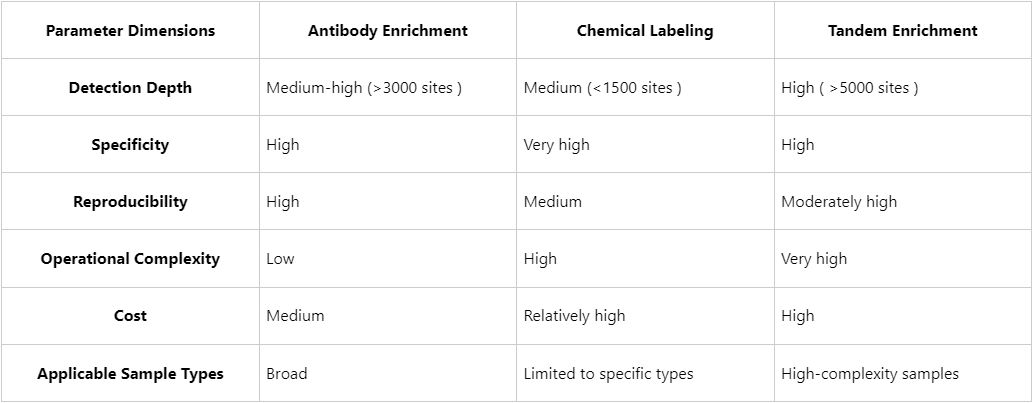How Different Enrichment Strategies Impact Acetylated Protein Detection: A Comparative Review
-
The procedure is straightforward and applicable to a wide range of sample types.
-
Commercial antibodies exhibit stable quality and high reproducibility.
-
High specificity makes it suitable for large-scale studies.
-
Variable recognition efficiency across different acetylation sites.
-
Antibody affinity directly influences enrichment depth.
-
Potential for non-specific binding.
-
High enrichment specificity.
-
Applicable to samples with limited starting material.
-
Improved recognition efficiency for certain novel acetylation forms (e.g., N-terminal acetylation).
-
Harsh chemical modification conditions may introduce background noise.
-
Multi-step workflows limit operational convenience and applicability.
-
Increased enrichment depth and proteome coverage.
-
Well-suited for complex samples or large-scale proteomic analyses.
-
Extended experimental workflows may cause substantial sample loss.
-
High demands on instrumentation and operator expertise.
- Large-scale modification mapping: Antibody enrichment with high specificity and reproducibility is preferable.
- Mechanistic studies (site-specific validation): Chemical labeling can be applied for targeted analysis.
- Tissue or clinical sample analysis: Sequential enrichment is recommended to improve detection of low-abundance peptides.
- Budget-limited projects: A mature antibody enrichment workflow combined with DDA acquisition mode offers the best cost-effectiveness.
- High-affinity anti–acetyl-lysine antibody enrichment platform.
- State-of-the-art Orbitrap Fusion Lumos and Exploris 480 mass spectrometry systems.
- DIA-based quantitative analysis workflows powered by Spectronaut.
- A dedicated bioinformatics team to support pathway elucidation and functional interpretation of acetylation.
Protein acetylation, a crucial post-translational modification in eukaryotes, plays a pivotal role in regulating diverse biological processes, including gene expression, metabolic homeostasis, and cell cycle progression. In recent years, advances in mass spectrometry have significantly deepened acetylome research. However, because acetylation events often occur at low abundance, direct detection by mass spectrometry is frequently hindered by signal suppression from high-abundance proteins. Consequently, selecting an appropriate enrichment strategy is a critical prerequisite for the successful characterization of acetylated protein detection.
Overview of Common Acetylation Enrichment Strategies
1. Anti–Acetyl-Lysine Antibody Enrichment
This approach employs monoclonal or polyclonal antibodies with high specificity for acetylated lysine to perform immunoaffinity purification of proteolytically digested peptides.
(1) Advantages
(2) Limitations
2. Chemical Labeling Combined with Affinity Purification
In this strategy, acetylation sites are chemically derivatized to introduce affinity tags (e.g., biotin), followed by capture using streptavidin-coated magnetic beads.
(1) Advantages
(2) Limitations
3. Sequential Enrichment Strategy
This method integrates multiple enrichment techniques (e.g., antibody enrichment combined with TiO₂ columns or strong cation exchange chromatography) in sequence to enhance the capture efficiency of modified peptides.
(1) Advantages
(2) Limitations
Comparative Analysis of Different Enrichment Strategies in Mass Spectrometry Applications
To facilitate interpretation, typical experimental parameters are used to compare the performance of these three strategies in acetylated protein detection:

Overall, for routine large-scale acetylome studies, anti–acetyl-lysine antibody enrichment remains the predominant approach, offering a balanced combination of efficiency, specificity, and operational simplicity. For studies aiming at broader proteome coverage or targeting specific modifications (such as N-terminal acetylation), chemical labeling and sequential strategies provide greater methodological flexibility.
Guidelines for Selecting an Appropriate Acetylation Enrichment Strategy
The optimal choice of enrichment method depends on the research objectives and sample characteristics:
MtoZ Biolabs’s Optimized Acetylated Protein Detection Solutions
MtoZ Biolabs provides a comprehensive, one-stop solution for acetylation modification research, including:
As research into epigenetic modifications advances, the precise capture and characterization of the acetylated proteome has become an essential approach for elucidating cellular functional networks. Careful selection and optimization of enrichment strategies directly influence the quality of acetylated protein detection and the depth and reliability of biological insights. MtoZ Biolabs is committed to supporting high-quality acetylation proteomics through cutting-edge platforms and extensive expertise. For tailored project solutions, please contact us at any time.
MtoZ Biolabs, an integrated chromatography and mass spectrometry (MS) services provider.
Related Services
How to order?







